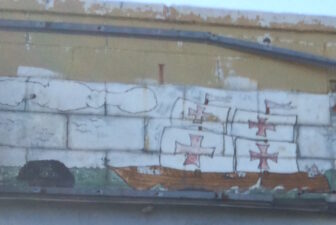“Amidst Chaos Lies Beauty” reads the graffiti on the huge abandoned mall owned by the Desire Community Housing Corporation. It sits in an overgrown field near the old Desire Housing Project on the eastern edge of the Upper 9th Ward.
Chaos aplenty: the dregs of a ruined utilitarian space, wood, busted-up furniture, plaster, nests of vermin. Beauty: yes, flowers, the colorful graffiti, someone’s neat and spacious improv home. And then a startling revelation that I walked right past, easy to miss: what appears to be history.
Peeking out from a wall where plaster is beginning to peel away is a mural painted on cinder blocks. Left to right, it features what appears to be one of Columbus’ ships, a slave captain being slain by Black warriors, an African tree and hut, the old Desire apartments and black men with bandoleers protecting them.
The graffiti artists have respectfully left it – the little that is exposed – unscathed.
Joseph Fraiman took me out there. I met him at a nearby warehouse where some movie props were being auctioned off. For $20 he bought a phone booth, which I coveted, and a huge metal sign that spelled EMERGENCY. “Don’t you get enough of that at work?” I asked. Joe is an emergency room doc in his residency at LSU’s new medical center, and he does search and rescue for the state.
From New York City’s Rockaway Queens district, he came down to New Orleans in 2012 to start a residency and to live in a place that he had connected with strongly when he visited his brother, then a Tulane undergrad.
The field of chaos and beauty caught Joe’s eye on a drive home from a search-and-rescue training in eastern New Orleans. He had run into multiple roadblocks because of an acid spill that was being cleaned up and was on Piety Street, trying to figure out how to get home, when he noticed the building. “It had a presence to it. I had my rescue boots on, and I enjoy these kind of impressive spaces.” So he stopped to take a closer look.
“There’s something very special here,” he texted his fellow resident Jenn Hissett, who is also an archaeologist. She looked at the pictures and decided that this had a 1970’s Black Panther tone.
I felt like Indiana Jones as Joe walked me down the road along the expanse of weeds and detritus …
When he made the discovery, Joe didn’t know he was near the site of the Panther shootout and the day-long Desire standoff of 1970, the topic of a book I wrote, and he’s too young to have personal memories of the Panther era. Nevertheless, when the mural caught his eye — especially those afro hairdos and the bandoleers — Joe immediately picked up on the Panther vibe. Preserved on concrete blocks thanks to some miraculous quality of the plaster undercoating, the mural struck him as rare and hidden and precious. Perhaps it has an important story to tell. His hunch became a theory as he checked into the history of the neighborhood.
He didn’t dare tear away more plaster to see what else was there for fear of exposing the art to the weather or attracting vandals. Instead he emailed The Lens which put him in touch with me.
I felt like Indiana Jones as Joe walked me down the road along the expanse of weeds and detritus, past what I now call the “Panther mural.” But what kind of an archaeologist am I? I didn’t notice the mural, even though it’s what I’d come out to see. What an eye Joe has! And what an adventurous, curious, respectful spirit!

This is pure conjecture on my part, but the mural could be a history wall. Reading left to right, it tells a story that includes the European “discovery” of America, a slave revolt (that captain being slain by Black warriors) right on up to the Panthers protecting the Desire Apartments.
The spirit of the Panthers re-emerged loud and clear in the Ninth Ward after Katrina hit, thanks to the extraordinary recovery work by former Panther Malik Rahim and the Common Ground Collective. (Malik doesn’t remember the mural from the 1970s.) My research tells me that the Panthers in New Orleans were a powerful and divinely protected force for good – champions of the poor, unifiers, revolutionary educators. So I take this painting as a timely message of all that the Panthers stood for as we approach the 50th anniversary of their founding this fall.
Could someone who knows more about art and preservation than I do please come forward and restore this auspicious, accidental find?
Orissa Arend is a mediator and psychotherapist in private practice in New Orleans. She is the author of “Showdown in Desire” about the Black Panther takeover of the Desire public housing project.


